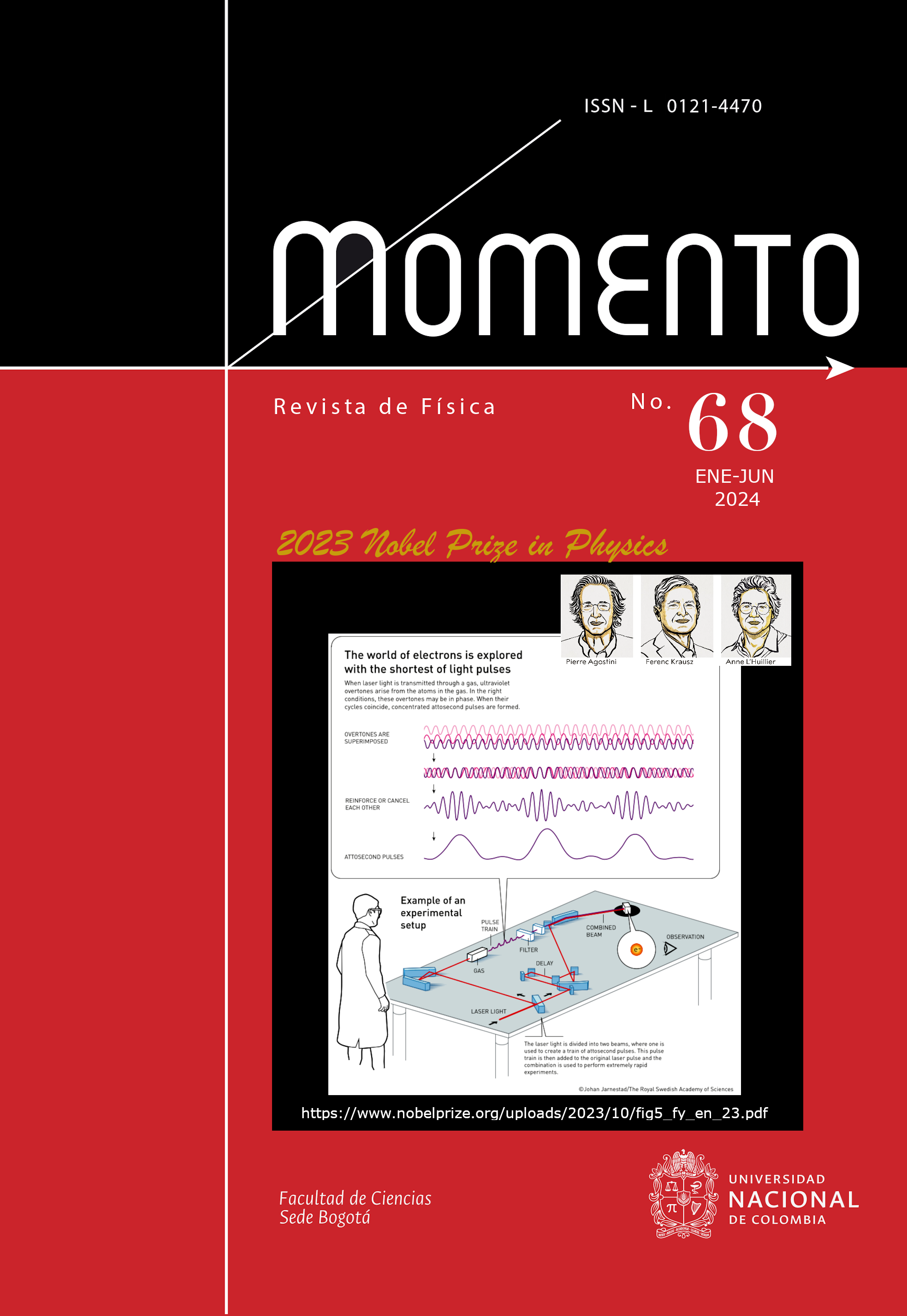RADIOPHARMACEUTICAL RENAL DOSIMETRY USING SNYDER / CRISTY-ECKERMAN / SEGARS ANTHROPOMORPHIC REPRESENTATIONS
DOSIMETRÍA RENAL DE RADIOFÁRMACOS UTILIZANDO REPRESENTACIONES ANTROPOMÓRFICAS DE SNYDER / CRISTY-ECKERMAN / SEGARS
DOI:
https://doi.org/10.15446/mo.n68.102552Keywords:
MIRD dosimetry, Snyder/Cristy-Eckerman /Segars representations for kidneys (en)Dosimetría MIRD, representaciones de riñones Cristy-Eckerman/Segars (es)
Downloads
Absorbed doses to the kidneys of adult patients are estimated using the Medical Internal Radiation Dosimetry (MIRD) methodology and the anthropomorphic representations of Snyder, Cristy-Eckerman, and Segars. The radiopharmaceuticals 99mTc(DTPA), 99mTc(DMSA) and 99mTc(MAG3) are used to perform renal function studies in adults. The dose results found for these radiopharmaceuticals and their representations will allow the exploring of their dosimetric impact on each other. The relative difference in total renal dose by using the Snyder/Segars and Cristy-Eckerman/Segars anthropomorphic-representations was 3.6% and 0.3% when using 99mTc(DMSA); 2.9% and 3.0% when using 99mTc(MAG3); 5.0% and 1.5% when using 99mTc(DTPA). Regardless of the radiopharmaceutical selected, the substitution of Segars phantoms for Snyder or Cristy-Eckerman phantoms does not reflect significant changes in the estimated absorbed dose to the kidneys.
Se estiman las dosis absorbidas por los riñones de pacientes adultos utilizando la metodología Medical Internal Radiation Dosimetry (MIRD) y las representaciones antropomórficas de Snyder, Cristy-Eckerman, y de Segars. Los radiofármacos 99mTc (DTPA), 99mTc (DMSA) y 99mTc (MAG3) se utilizan para realizar estudios de función renal en adultos. Los resultados de dosis encontrados para estos radiofármacos y sus representaciones permitirán explorar su impacto dosimétrico entre ellas. La diferencia relativa en la dosis renal total al utilizar las representaciones antropomórficas de Snyder/Segars y Cristy-Eckerman/Segars fue del 3,6 % y del 0,3 % al utilizar 99mTc (DMSA); 2,9% y 3,0% cuando se usa 99mTc(MAG3); 5,0% y 1,5% cuando se utiliza 99mTc(DTPA). Independientemente del radiofármaco seleccionado, la sustitución de los fantomas de Segars por los fantomas de Snyder o Cristy-Eckerman no refleja cambios significativos en la dosis absorbida estimada en los riñones.
References
M. Vasquez -Arteaga and et al.2021, Appl. Radiat. Isotopes 176, 109888 (2021). https://www.sciencedirect.com/science/article/pii/S0969804321002888 DOI: https://doi.org/10.1016/j.apradiso.2021.109888
ICRP Publication 53, Ann ICRP 18, 1 (1988). https://www.icrp.org/publication.asp?id=ICRP%20Publication%2053
S. Mattsson, L. Johansson, and et al., Ann ICRP 44, 7 (2015). https://doi.org/10.1177/0146645314558019 DOI: https://doi.org/10.1177/0146645314558019
ICRP Publication 80, Ann ICRP 28, 3 (1998). https://www.icrp.org/publication.asp?id=ICRP%20Publication%2080
R. Loevinger, T. Budinger, and et al., Mird Primer for Absorbed Dose Calculations Revised, Subsequent Edition (Society of Nuclear Medicine, 1991). https://www.amazon.com/-/es/Robert-Loevinger/dp/0932004385
J. Ryman, G. Warner, and K. Eckerman, ALGAMP — a Monte Carlo radiation transport code for calculating specific absorbed fractions of energy from internal or external photon sources (Oak Ridge National Laboratory Report ORNL/TM-8377, 1987). https://link.springer.com/chapter/10.1007/978-3-662-07310-0_4
L. Choon-sik and L. Jai-ki, Nucl. Eng. Technol. 38, 239 (2006). https://www.koreascience.or.kr/article/JAKO200603018220094.page
S. Lamart, A. Bouville, and et al., Phys. Med. Biol. 56, 7317 (2012). https://iopscience.iop.org/article/10.1088/0031-9155/56/22/020 DOI: https://doi.org/10.1088/0031-9155/56/22/020
W. Snyder, H. Fisher, and et al., J. Nucl. Med. 3, 7 (1969). https://pubmed.ncbi.nlm.nih.gov/5802194/
ICRP Publication 23, Pergamon Press (1975). https://www.icrp.org/publication.asp?id=ICRP%20Publication%2023
W. Snyder, H. Fisher Jr, and et al., J. Nucl. Med. 3, 7 (1969). https://pubmed.ncbi.nlm.nih.gov/5802194/
M. Cristy, OSTI.GOV (1980). https://www.osti.gov/biblio/5308345
M. Cristy and K. Eckerman, OSTI.GOV (1987). https://www.osti.gov/biblio/6202949/
M. Zankl, N. Petoussi, U. Fill, and D. Regulla, Radiat. Prot. Dosimetry 105, 539 (2003). https://doi.org/10.1093/oxfordjournals.rpd.a006299 DOI: https://doi.org/10.1093/oxfordjournals.rpd.a006299
ICRP Publication 89, Ann ICRP 32, 3 (2002). https://www.icrp.org/publication.asp?id=ICRP%20Publication%2089
W. Segars, Development of a new dynamic NURBS-based cardiac-torso (NCAT) phantom (2001). https://www.semanticscholar.org/paper/Development-of-a-new-dynamic-NURBS-based-(NCAT)-Segars/30cf9cbcfe47699b1120e1f18f90a6ef12eae47a
G. Xu, C. Shi, and et al., Handbook of Anatomical Models for Radiation Dosimetry (CRC Press, 2009) p. 32. https://www.taylorfrancis.com/chapters/edit/10.1201/EBK1420059793-18/pregnant-female-fetus-computational-phantoms-latest-rpi-series-representing-3-6-9-month-gestational-periods-george-xu-chengyu-shi-michael-stabin-valery-taranenko
T. Chao and X. Xu, Phys. Med. Biol. 46, 901 (2001). https://dx.doi.org/10.1088/0031-9155/46/4/301 DOI: https://doi.org/10.1088/0031-9155/46/4/301
M. Stabin and J. Siegel, J. Nucl. Med. 59, 154 (2018). https://jnm.snmjournals.org/content/59/1/154 DOI: https://doi.org/10.2967/jnumed.117.196261
M. Vasquez and et al., Momento 64, 54 (2022). https://doi.org/10.15446/mo.n64.99290 DOI: https://doi.org/10.15446/mo.n64.99290
D. Weber and et al., MIRD: Radionuclide Data and Decay Schemes (Society of Nuclear Medicine, 1989). https://www.abebooks.com/9780932004321/Mird-Radionuclide-Data-Decay-Schemes-0932004326/plp
Sociedad Española de Radiofarmacia, Dosis de radiación recibida por los pacientes tras la administración de radiofármacos (Revised march, 2022). https://serfaradiofarmacia.com/wp-content/uploads/2009/07/Dosis_de_radiacion.pdf
HPS, Health physics society (Revised march, 2022). https://hps.org/publicinformation/radardecaydata.cfm
How to Cite
APA
ACM
ACS
ABNT
Chicago
Harvard
IEEE
MLA
Turabian
Vancouver
Download Citation
License

This work is licensed under a Creative Commons Attribution-NoDerivatives 4.0 International License.
Those authors who have publications with this journal, accept the following terms:
a. The authors will retain their copyright and will guarantee the publication of the first publication of their work, which will be subject to the Attribution-SinDerivar 4.0 International Creative Commons Attribution License that permits redistribution, commercial or non-commercial, As long as the Work circulates intact and unchanged, where it indicates its author and its first publication in this magazine.
b. Authors are encouraged to disseminate their work through the Internet (eg in institutional telematic files or on their website) before and during the sending process, which can produce interesting exchanges and increase appointments of the published work.




















